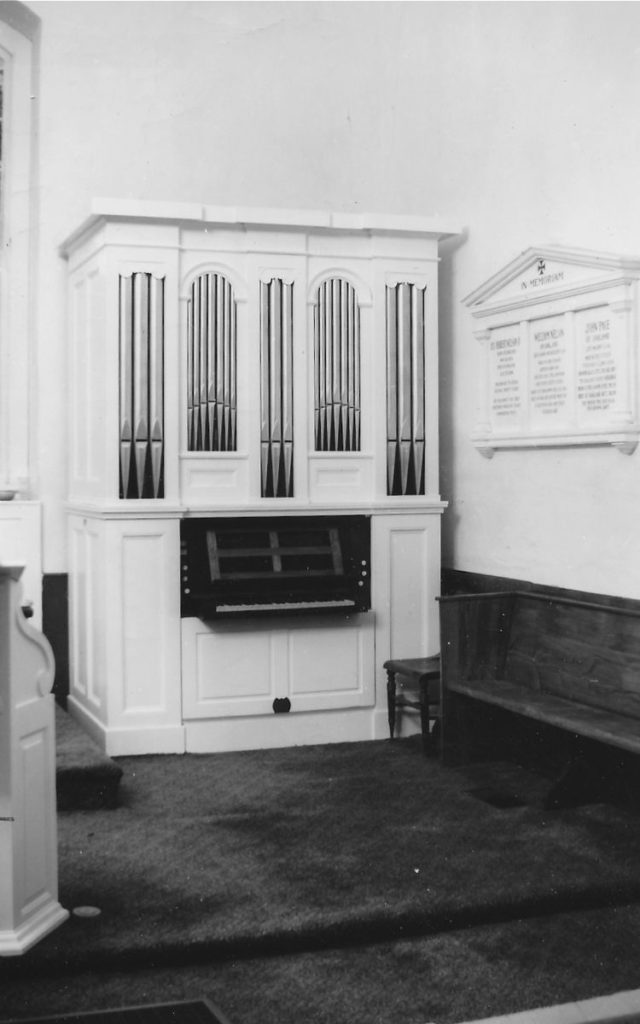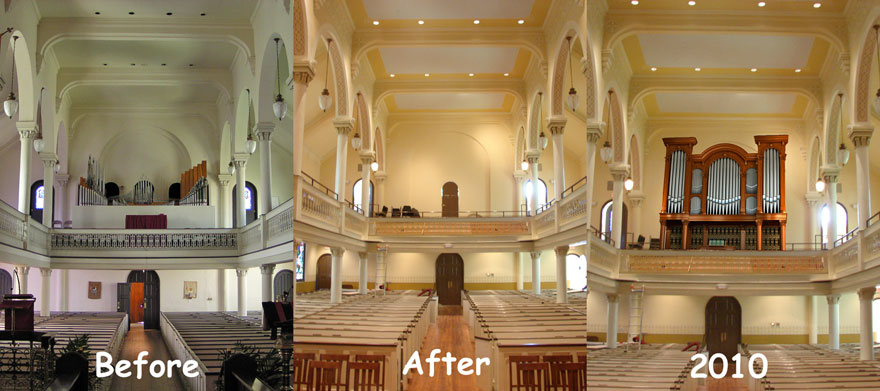Music was late in coming to the colonial church. Barbara Willis wrote in the “Three Churches of St. George’s that “In 1770, the church was repaired and a gallery erected in the new addition. In 1789, an addition was made to the south side of the Church “so as to form the said Church into a cross”. Also in that year, an organ was placed at the end of the singers’ gallery.’ That’s based on Slaughter’s history
However, the Vestry minutes state that years later June 30, 1796, said that Dr. Charles Mortimer had offered the gift of an organ. The Vestry authorized it and the church trustees directed it would be placed at the end of the singers’ gallery. Typically the singers’ gallery would be at one side and housed the “Singers” who if accompanied sang the services and led the service. We don’t know in what section of the “cross” the organ was placed.
One organ or two, 1789 and or 1796? In typical fashion an organ was donated.
Dr. Charles Mortimer was the first mayor of Fredericksburg after its incorporation in 1782 and was very wealthy. He also early on was one of Mary Washington’s physicians as well as director of the Alum Springs Hospital during the Revolution. The home at 213 Caroline, originally built in 1764 for John Dixon of Williamsburg was purchased in 1772 by Mortimer. Legend has it Mortimer hosted a dinner in his dining room in 1784 that counted George Washington, the Marquis de Lafayette and the Count de Rochambeau among the guests.
We know nothing about the singers in this church or any details of music. This would include the second church 1815-1848. In the creation of St. George’s there was an organ in the back in 1849 since an eyewitness quoted by Quenzel said “Mary Green did her best on the organ”
The 1849 organ gave way to the Berger organ after the 1854 fire. The organ was valued according to Quenzel at $1,250 and was considered part of the loss.
Henry F. Berger was a German immigrant who was 30 years old when he came to this country in 1849. With no swell or pedal stops it is typical of the organs built in the 17th and 18th centuries and is one of only two Berger organs known to have survived. It was restored by the late Cleveland Fisher in 1963
Henry F. Berger was born near Toulouse, France, in 1819 and learned the skills of organ building from his father. He came to this country in 1849. He made church organs and other musical instruments in Baltimore, Md., and later in York, Pa., until fire destroyed his factory and three finished organs on March 10, 1861. In September 1855 he completed the organ that was at St. George’s until 1874

Right Side:
Open Diapason (37 pipes)
Stop’d Diapason Treble (37 pipes)
Principal (54 pipes)
Left Side:
Stopped Diapason Bass (17 pipes)
Dulciana (37 pipes)
Fifteenth (54 pipes)
Compass 54 notes, unenclosed.
The Vestry approved that St. George’s should give up the Berger organ for a new one.
The women did fundraising for a new organ in the 1870’s which they expected to cost $3K in April, 1873 they net $100 from a concert at Citizen’s Hall. A concert in Jan., 1874 featured Leo P. Wheat pianist from Richmond; Mr. Samuel G. Young, one of the finest amateur baritones, a brilliant soprano and Profs. Bowering and Keyser
An organ was ordered for $3K in March, 1874. It was not until May, 1875 they were preparing a gallery for the new organ. The organ was ready by June, 1875. The Vestry thanked Mrs. Belle Taylor and other ladies for their fundraising. The Virginia Herald reported on June 7, 1875 that it was the “best $3,000 organ we have ever heard. “”Its musical exhalations are sweet and fall harmoniously on the ear. When in full volume it is majestic and awe-inspiring.”
We know little of what was played on organ except for Christmas services which were publicized in the newspapers.
The details of the choir are also missing. We do know there was a paid choir in 1883 with 2 paid singers at “no more than $100 per annum” which was encouraged by the minister of the time, Rev. John Mason who was also a musician. There were still paid choir members in 1906 when Houston Sweetzer sang for $6 a month
We do know there was a dispute in the choir which involved the organist. As quoted by Quenzel
“Apparently some friction existed in the choir in 1910 as the vestry formally spread upon its minutes an order stating that “no complaints shall be made by a member of the choir about a fellow member except to the rector or to the organist,” and “when members cannot agree as to the merits of each other they should be locally separated while singing.” The vestry especially commended to all “the members of the Choir the observance of that Christian Charity to each other which alone can make the Choir a blessing to the congregation.”
This organ would last until 2007- at least in part. In 1950 new chests, a trumpet stop, and chimes are added to the organ. A rededication is held, commemorating the men and women who served in World War II.
The organ was moved from the gallery to the front with the 1925 renovation. The Vestry room was eliminated, the chancel enlarged and choir stalls added.
Mary Washington College dropped its organ courses in 1983 and traded its four organs for an electronic one and then sold them to St. George’s for $9,000. Ranks of pipes and wind chests from each were reassembled and rewired in the west gallery. St. George’s organ had increased in size 3.5 times Irving G. Lawless, organ curator for Kennedy Center, was hired to put the organ together. Kenneth Lundberg, an organ consultant from Pennsylvania, supervised the project.
In February, 1984, the fund raising began with subcommittees established for memorials, publicity, plaques, brochures, and pledges. The rear organ was in place for a dual organ recital with Guthrie and Dr. William Munsie, then a pathologist at Mary Washington Hospital. The committee decided in the summer of 1984 to renovate the organ in the west gallery followed by the chancel organ. $125,000 was raised and after four years from Guthrie’s original call, the work had been done. In October, 1987, the organ was dedicated by a concert of Douglas Major, then associate organist-choirmaster at the Washington Cathedral.
By the turn of the century, the old organ was difficult to maintain.
The organ committee led by Erik William Suter then organist at the National Cathedral met after 2002 to decide about whether the church should embark upon procuring a new organ or renovating what was here. They decided the existing 1875 organ supplemented by an additional organ from Mary Washington College should not be renovated but that a new organ be purchased. In this case it would be custom built. The original design was expanded from 2 manuals to 3.
After a review of organ builders, the committee settled on Parsons Organ Builders of Canandaigua, NY. The firm is owned and operated by two brothers, Richard “Ric” and Calvin “Cal” Parsons, both of whom are fourth generation organ builders. In 1979, they purchased the firm that their grandfather founded in 1921. With a total staff of 15, they have built, remanufactured and maintain a large number of instruments throughout the US.
During the design process, Parsons worked closely with our architect during the renovations Jim Wollon, to incorporate design elements of St. George’s architecture into the organ case. The goal was to create an organ that blended well with the interior of our nave and looked like it had always been there.
These elements include:
1) Three large arches that reflect the Ascension window over the
altar,
2) Columns with carved capitals similar to those in the sanctuary,
3) Lower case grillwork to match the grillwork in the gallery rails, and
4) A rich walnut case built in the Italianate style, with polished tin
façade pipes.
The final organ took 3 years to be constructed. It involved the church prepaying the purchase of pipes in 2007 $126,750 to get the best exchange rates since the pipes are European. The action on the organ is tracker, a mechanical mechanism. It provides a linkage between keys or pedals pressed by the organist and the valve that allows air to flow into pipe(s) of the corresponding note. The trackers extend below the organ to connect with the pipes. The entire organ was constructed at Parson’s shop in New York, disassembled and brought to St. George’s. Final implementation took 2 months in late 2009.
The organ was dedicated in 2010 with the following characteristics
Parsons Opus 29
3 Manual and Pedal
44 ranks—47 Stops
2667 pipes
The Great, or main division of the organ is located in the center of the case. The Positiv division is split on both sides of the Great, with the Swell division inside the tower. The Pedal pipes will be located both in the tower and inside the main case
This picture series by Ralph Powell captures the changes:

